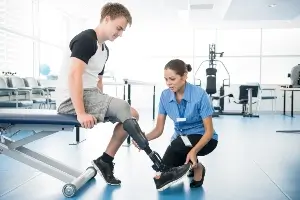Recovering fair compensation for a catastrophic car crash injury involves dealing with obstacles that don’t exist in typical injury claims. The stakes are higher, the process is more complex, and insurance companies fight harder to minimize payouts.

At TSR Injury Law, our experienced car crash lawyers in Bloomington understand the unique difficulties catastrophic injury victims face when pursuing compensation. We are tireless advocates for our clients and have helped countless victims with catastrophic injuries navigate complex claims, securing favorable outcomes and resources they need for long-term care and recovery. Our knowledgeable legal team anticipates challenges before they arise and develops strategies to address them effectively.
If you’re dealing with catastrophic injuries from a car crash, navigating this process alone could leave you with thousands of dollars less than you deserve. Contact us today to see how we can help. Your initial consultation is completely free, and we welcome your questions. We’ll explain the challenges you may face and what legal options you may have for seeking full compensation.
What Makes Catastrophic Injury Claims More Difficult Than Typical Car Crash Cases?
Catastrophic injury claims are tough because often you need to prove damages that extend decades into the future. Minor injury claims, which are short-term, often involve medical bills you’ve already received and wages you’ve already lost. Catastrophic claims require projecting lifetime medical needs, estimating future lost earnings, and quantifying how permanent disabilities will affect your quality of life for years to come.
The documentation requirements for a catastrophic injury case are significantly more complex. At a minimum, you will need the following:
- Comprehensive medical records
- Expert testimony
- Life care plan
- Economic analyses
- Vocational assessments
Each element must be thoroughly documented and supported by credible professionals. Missing or incomplete documentation gives insurance companies ammunition to dispute your claim’s value.
Settlement timelines also create pressure. You may be dealing with mounting medical bills and lost income while your claim remains unresolved. Insurance companies know this financial pressure exists. They use it as leverage, hoping you’ll accept inadequate settlements rather than wait for fair compensation.
Multiple parties and insurance policies often come into play. The at-fault driver’s personal auto policy may provide only a fraction of what you need. You might need to pursue your underinsured motorist coverage, business liability policies, or other sources. Coordinating claims across multiple policies adds complexity and extends the process.
The permanent nature of catastrophic injuries means you only get one chance to settle correctly. Once you accept a settlement and sign a release, you cannot come back for more money, even if your actual costs exceed expectations. This finality makes accurate damage calculation absolutely critical.
How Do You Prove the Full Extent of Your Catastrophic Injuries?
Proving catastrophic injuries requires more than submitting medical bills and records. You must demonstrate how injuries affect every aspect of your life now and will continue affecting you permanently.
- Comprehensive Medical Documentation: Your treating physicians will need to provide detailed records showing your diagnosis, treatment, prognosis, and limitations. Generic medical notes are not enough for this type of high-value claim. You need specific statements about permanent impairments and functional limitations.
- Diagnostic Evidence: MRI results, CT scans, X-rays, and other imaging provide objective proof of injury severity. These diagnostic tools show structural damage that insurance companies cannot easily dispute.
- Expert Medical Testimony: Respected medical professionals must explain your injuries, treatment needs, and prognosis to insurance adjusters or juries. Their opinions carry weight that your own statements cannot match.
- Functional Capacity Evaluations: These assessments objectively measure what you can and cannot do physically. They document limitations that affect your ability to work and perform daily activities.
- Impact on Daily Life: Videos, testimony, and documentation in a pain journal that shows how your injury forces you to navigate daily tasks differently. This “real-world” documentation demonstrates your new reality in a way that medical records alone cannot convey.
- Psychological Evaluations: Catastrophic injuries often cause victims to experience depression, anxiety, and PTSD. Mental health professionals document these changes as part of your overall damages.
Each piece of evidence contributes to a full picture of how your catastrophic injuries have altered your life permanently. If there are gaps in your documentation, insurance companies will use it to their advantage to minimize your claim,.
What Challenges Could Come Up When Calculating Future Medical Costs and Care Needs?
Estimating your medical expenses over a lifetime is challenging, because your attorney needs to predict your future needs – and their costs – that span decades or a lifetime. Insurance companies will use any uncertainty in this process to dispute projected costs.
Here are some of the specific challenges of calculating future medical costs and care needs:
- Changes to Medical Technology: Treatment options evolve constantly. Predicting what care will be available and necessary 20 or 30 years from now involves educated guesswork that insurance companies challenge.
- Inflation and Cost Increases: Healthcare costs rise faster than general inflation. Life care plans must account for these increases, but insurance companies dispute inflation projections as excessive.
- Life Expectancy Debates: How long you’ll need care directly affects total costs. Insurance companies hire experts who argue for shorter life expectancies to reduce projected expenses.
- Complications and Secondary Conditions: Catastrophic injuries often lead to additional health problems over time. Predicting and costing these future complications involves some degree of uncertainty that insurers exploit.
- Home and Vehicle Modifications: Wheelchair accessibility, specialized equipment, and vehicle adaptations cost substantial sums. Insurance companies dispute necessity or argue for cheaper alternatives.
- Attendant Care Needs: Whether you’ll need full-time care, part-time assistance, or family help affects costs dramatically. Insurers minimize these projections and dispute hourly rates.
Life care planners develop comprehensive cost projections, but insurance companies hire their own experts who typically project lower costs.
How Does Inadequate Insurance Coverage Complicate Catastrophic Injury Claims?
Minnesota’s minimum insurance requirements fall far short of covering catastrophic injury costs. When the at-fault driver carries only basic coverage, it limits the compensation you can recover.
The at-fault driver’s personal assets rarely bridge this gap. Most people don’t have millions in assets available to satisfy judgments. Even if you win a substantial verdict, collecting it becomes virtually impossible if the defendant lacks resources.
UM/UIM Motor Vehicle Coverage Helps to Fill Gaps If the At-Fault Driver’s Insurance is Not Enough
In these type of situations, your own insurance becomes critical. Carrying underinsured motorist coverage helps to fill critical gaps if the at-fault driver’s insurance is insufficient. If the at-fault driver has no insurance, your uninsured motorist coverage.
Minnesota’s Minimum Requirements for UM/UIM Coverage
In Minnesota, all drivers are required to carry a minimum of $25,000 per person and $50,000 per incident. This additional coverage provides an additional source for compensation. You would need to make a claim against your own policy for the amounts the at-fault driver’s insurance doesn’t cover.
Your Attorney Should Rule Out All Possible Sources of Compensation
Identifying all potential sources of compensation requires thorough investigation. Was the at-fault driver working when the crash occurred? Employer liability might apply. Was a defective vehicle part involved? Product liability claims might exist. Multiple defendants and policies can provide additional compensation sources.
Minnesota Allows Drivers to Stack Policies (If They Don’t Waive That Right)
In Minnesota, you might be able to increase your No Fault coverage by combining limits on multiple cars (the insurance term is called stacking) to get more money initially after a collision. But this gets complicated fast and you have to be careful about signing anything because insurance companies make this process confusing on purpose. They may offer you a settlement or ask you to sign papers. Often, they may do this without clearly explaining first that by doing so, you are giving up your right to money from your other insurance policies. Signing this type of document could be a huge mistake that ends up costing you thousands.
What Evidence Is Critical for Building a Strong Catastrophic Injury Claim?
Catastrophic injury claims stand or fall on the quality of evidence supporting them. Insurance companies know this and look for weaknesses they can exploit to reduce payouts. To have a really strong case, you need to begin building evidence from day one.
Critical evidence for a catastrophic injury claim includes:
Crash Scene Evidence
Police reports, witness statements, photographs, and physical evidence establish how the crash occurred and who bears responsibility. This evidence deteriorates quickly as memories fade and physical conditions change. When you hire our law firm, we can begin gathering evidence on your behalf from day one.
Medical Records From Day One
Having complete documentation that begins immediately after the crash shows a hard-to-dispute injury timeline. With catastrophic injuries especially, any gaps in treatment or delayed medical attention give insurance companies valid opportunities to question whether your injuries really are severe.
Economic Documentation
Tangible records, like tax returns, pay stubs, employment records, and benefit statements, prove lost income and earning capacity. Without solid economic evidence, insurance companies dispute lost wage calculations.
Life Care Plans
Comprehensive projections from qualified life care planners detail future medical needs and costs. These plans must be thorough, developed by credible professionals, and well-supported with documentation.
Expert Opinions
Medical experts, economists, vocational specialists, and other professionals may be needed to provide testimony that insurance adjusters and juries rely on heavily. The quality and credibility of your experts directly affects your claim’s value.
Personal Impact Evidence
Recording your recovering journey by documenting your injuries, daily pain levels, and how your injuries are preventing you from enjoying your life or even doing basic activities, like household work, making your food, or bathing. Testimony from family members, friends, and colleagues also helps. They can share their direct observation of how your injuries have changed your life. Before-and-after comparisons show losses that medical records alone cannot capture.
Gathering this evidence takes time and resources. Every day that passes without taking action allows critical evidence to disappear. The timing and thoroughness involved in gathering evidence matters, but this is something we can help you with.
How We Help Clients Overcome These Challenges
Our legal team has managed many catastrophic injury claims throughout Minnesota, so we are very familiar with the potential problems and challenges that may arise. Our approach addresses each challenge systematically – we build claims that insurance companies must take seriously.
- We Provide Legal Guidance: Our legal team guides you throughout the legal process, which includes helping you gather the evidence needed for your case. With catastrophic injuries, this may often include consulting with medical experts, life care planners, economists, and vocational specialists to provide credible evidence for your claim. We work closely with these professionals to make sure their work stands up under the insurance company’s scrutiny.
- We Thoroughly Investigate Financial Resources: A thorough investigation includes reviewing all available insurance policies, examining employer liability, and exploring other avenues that maximize available resources. In short, we identify all available coverage to make sure we don’t leave money on the table.
- We Handle Communication With the Insurance Companies: We are very familiar with the tactics insurance adjusters may attempt, so we handle communication on your behalf to protect your legal rights. We make sure they don’t pressure you into accepting inadequate settlements that don’t even begin to cover all your damages. We negotiate from positions of strength backed by solid evidence and preparation.
- We Move Quickly to Preserve Evidence: This includes taking legal steps to ensure video footage of your collision or other key evidence is not lost, overwritten, or destroyed. We also make sure you fully understand the full financial impact of your injuries before you accept any settlement offer.
Contact TSR Injury Law for Help With Your Catastrophic Injury Claim
Catastrophic injury claims are too complex and valuable to handle without experienced legal guidance. The challenges are real, the stakes are high, and insurance companies have significant resources working against you.
At TSR Injury Law, we’ll explain the specific challenges your claim faces and how we can help you overcome them. And since we take injury cases on contingency, there are no upfront costs or out-of-pocket fees to worry about when you hire our firm. We only get paid if we recover compensation for you.
Contact TSR Injury Law today. We would be honored to help you. (612) TSR-TIME




